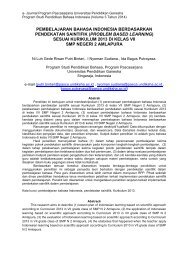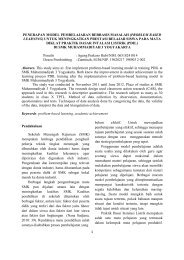You also want an ePaper? Increase the reach of your titles
YUMPU automatically turns print PDFs into web optimized ePapers that Google loves.
1 Atomic structure and the periodic table<br />
TIP<br />
In all these reactions a non-metal is<br />
displacing another non-metal.<br />
Potassium chloride (aq)<br />
Potassium bromide (aq)<br />
Potassium iodide (aq)<br />
In a similar way, a more reactive non-metal can displace a less reactive<br />
non-metal from a compound. This means that a more reactive halogen<br />
can displace a less reactive halogen from a halide compound.<br />
This can be seen when aqueous solutions of the halogens react with<br />
aqueous solutions of halide compounds (aqueous means dissolved in water).<br />
Chlorine (aq) Bromine (aq) Iodine (aq)<br />
chlorine + potassium bromide →<br />
potassium chloride + bromine<br />
Cl 2 + 2 KBr → 2 KCl + Br 2<br />
(Cl 2 + 2 Br − → 2 Cl − + Br 2 )<br />
Yellow solution formed (due to<br />
production of bromine)<br />
Chlorine displaces bromine<br />
chlorine + potassium iodide →<br />
potassium chloride + iodine<br />
Cl 2 + 2 KI → 2 KCl + I 2<br />
(Cl 2 + 2 I − → 2 Cl − + I 2 )<br />
Brown solution formed (due to<br />
production of iodine)<br />
Chlorine displaces iodine<br />
No reaction<br />
Bromine cannot displace chlorine<br />
bromine + potassium iodide →<br />
potassium bromide + bromine<br />
Br 2 + 2 KI → 2 KBr + I 2<br />
(Br 2 + 2 I − → 2 Br − + I 2 )<br />
Brown solution formed (due to<br />
production of iodine)<br />
Bromine displaces iodine<br />
No reaction<br />
Iodine cannot displace chlorine<br />
No reaction<br />
Iodine cannot displace bromine<br />
It can be seen from these reactions that the trend in reactivity for<br />
these three halogens is:<br />
▲ Figure 1.5 Colourless chlorine<br />
water reacts with colourless potassium<br />
bromide solution to form yellow bromine.<br />
Most reactive Chlorine<br />
Bromine<br />
Least reactive Iodine<br />
In general, the further down the group the less reactive the halogen.<br />
The higher up the group, the more reactive the halogen. This means<br />
that fluorine is the most reactive halogen. You will not do experiments<br />
with fluorine because it is very reactive and toxic.<br />
When the halogens react they gain one electron in order to get a full<br />
outer shell. The further down the group, the electron gained is further<br />
away from the nucleus as the atoms get bigger. This means that the<br />
electron gained is less strongly attracted to the nucleus and so harder<br />
to gain. The harder the electron is to gain, the less reactive the<br />
halogen.<br />
fluorine (2,7) chlorine (2,8,7)<br />
The further down the group, the further the<br />
electron gained is from the nucleus<br />
TIP<br />
The explanation for the reactivity<br />
trend in Group 7 is about the distance<br />
between the nucleus and the electron<br />
gained which is from outside the atom<br />
– it is not about the outer shell electrons.<br />
Test yourself<br />
35 Why are the halogens reactive?<br />
36 All the halogens are made of diatomic molecules. What are diatomic<br />
molecules?<br />
37 Predict what would happen and why if fluorine and sodium chloride were<br />
mixed.<br />
38 Bromine reacts with chlorine to form a molecular compound. Explain<br />
why this reaction happens.<br />
39 Explain why chlorine is more reactive than bromine.<br />
18





